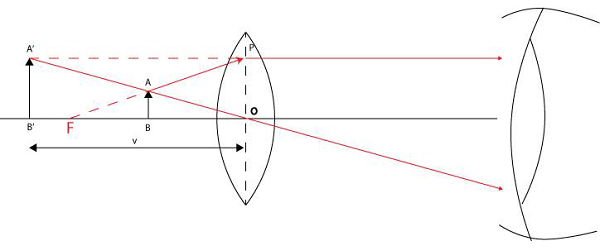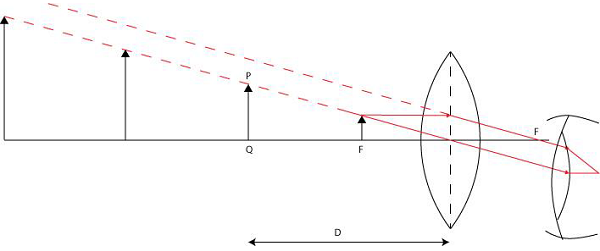Microscope-Simple
Description:
Microscope is a device to observe large (magnified) image of small object i.e. microscope work on the principle of magnification.
Simple microscope uses a signal convex lens.
Magnification is given by −
Magnification = Size of ImageSize of Object
Magnification can be also given as −
Magnification = Angle subtended by ImageAngle subtended by Object
Observation
When the object is placed near to the eye it appears to be magnified as object closer to eye will have larger angle.
Self-adjustment of human eye / Accommodation
When an object is placed far away it is not clearly visible to human eye, but when we move the object closer to the eye, the object is visible clearly and magnified this occurs because human eye is capable of changing its focal length to view object clear and magnified. This is known as selfadjusting nature if human eye.
But when the object is brought too close to the eye, the sharp image of the object on the retina cannot be formed and the object is viewed as not clear. This happens when the maximum limit of adjustment of human eye is crossed and it is known as least distance of distinct vision (D).
Least distance of distinct vision is the minimum distance at which eye can view the object sharp and clear. For health eye it is 25cm.
To study about microscope we will use the following figure −
Case 1
A convex lens is used with object placed between optical center and the focus point of the image.
We will consider two rays from point A, first ray is directed towards optical enter and it moves without deviation. Second ray is along the direction of focus i.e. when drawn backwards the ray seems to emerge from Focus. This second ray becomes parallel after refraction.

The image is formed by backtracking the rays as shown.
We have −
Magnification = Image distanceObject distance
i.e.
m = vu
We also know that −
1v - 1u = 1f
Multiplying equation by v
∴ 1 - vu = vf
∴ 1 - m = vf
∴ m = 1 - vf
If image is formed at D then,
v = -D
Substituting value, we get −
∴ m = 1 + Df
This is known as magnification formula for simple microscope.
Case 2
When eye is in relaxed state i.e. incident rays are parallel.
Object is placed on focus so, the two rays (first ray which is directed towards optical center and second ray which is parallel to the principle axis) are parallel to each other when they reach the eye.

Let,
β = Angle suspended by image.
If object is placed at the same location as that of image then −
α = Angle suspended by object.
So, magnification is given by −
∴ m = βα
For small value of α and β
α = tan α and β = tan β
Therefore,
m = tan βtan α
From figure −
m = ABBOABQO
∴ m = QOBO
Substituting values as optical distances −
m = -D-f
∴ m = Df

